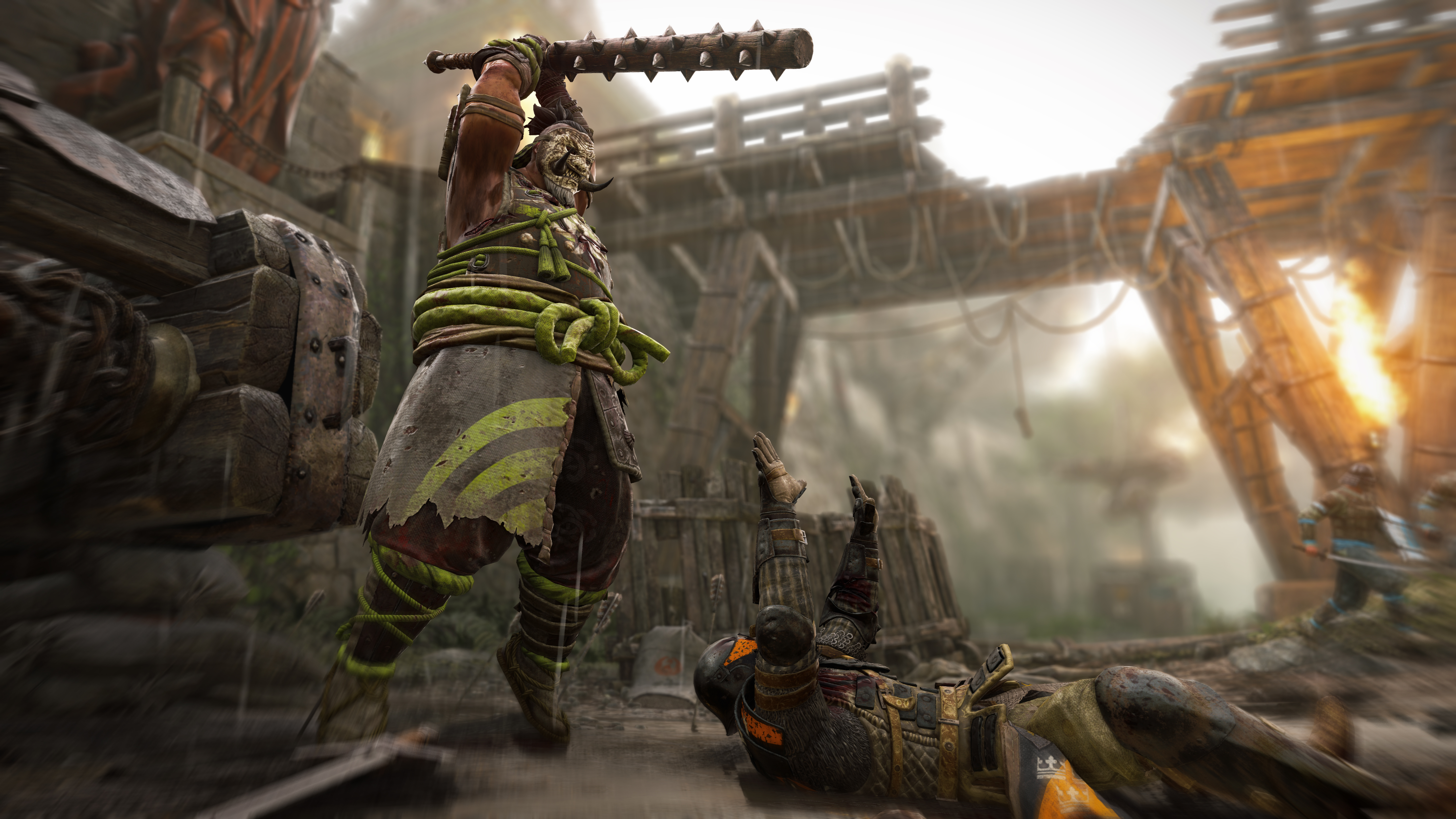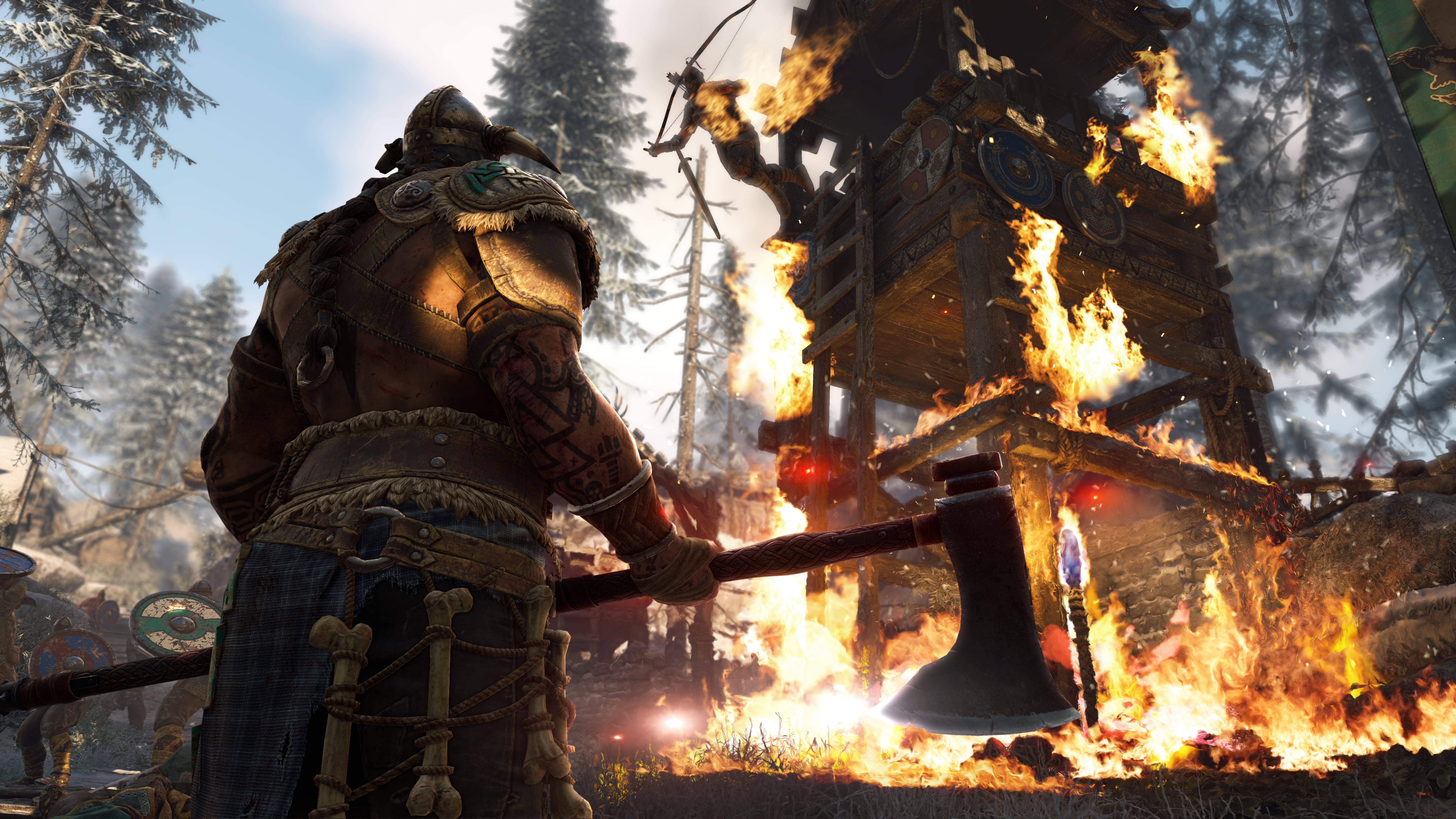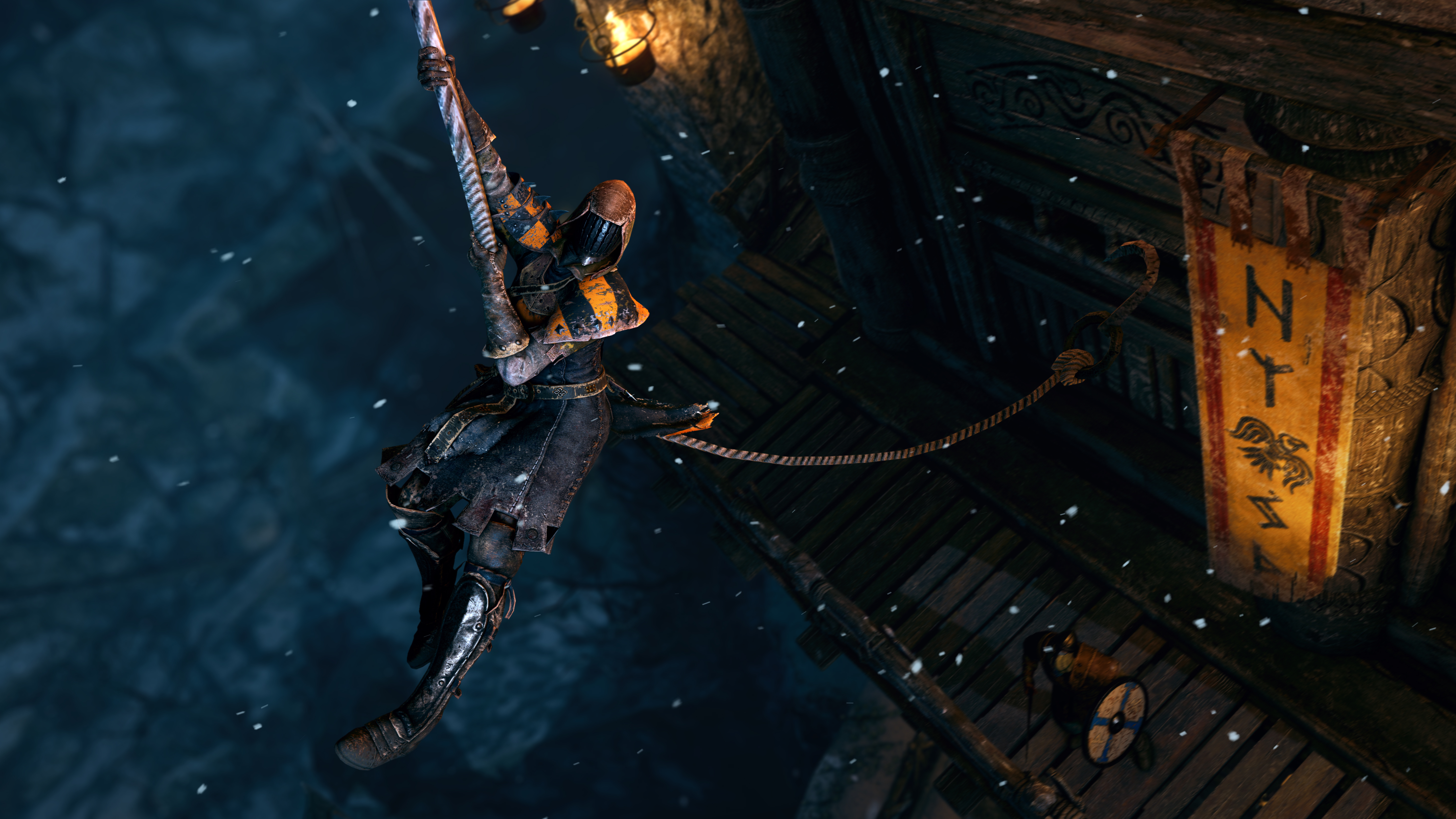Endless War: An Extended Preview Of Multiplayer and Singleplayer Gameplay In 'For Honor' (Updated)
Update, 12/14/2016, 11:17 am PST: Corrected a statement that said that the Peacekeeper was an Assassin class for the Samurai when in fact it is a member of the Knights faction.
With For Honor on the way in two months time, Ubisoft wanted to show off more content for its upcoming title. Two weeks ago, I was invited to San Francisco to check out new elements in its multiplayer experience and spend more time with the campaign. Once again, however, the multiplayer was the highlight of the session. Ubisoft Montreal has some ambitious plans for online play with For Honor that makes every round count towards an overall goal for each player.
For Lands And Faction
This “overall goal” comes in the form of Faction War, the overarching meta game in For Honor’s multiplayer. When you enter online play for the first time, you’ll have to choose from one of the game’s three main factions: Samurai, Viking, or Knight. From there, you’ll see a bird’s-eye view of the equally-portioned territories held by each faction. Throughout the course of a season, which takes 10 weeks, you and your fellow faction brethren will participate in many battles against players of another group to slowly gain control of more territory. With each win, you garner War Assets that you can allocate to different frontline, or disputed, territories. Between two warring factions, the group with the most War Assets in that area wins the territory. The process continues until the end of the season when the faction with the most territory is declared the winner.
As the season rages on, game director Roman Campos Oriola said the shift in the balance of power over the course of a season might also mean a temporary alliance between two of the three factions. He also explained that each disputed area has a specific game mode in mind, but players shouldn’t feel like they can only contribute War Assets onto one particular territory.
“Each frontline is [assigned] a game mode or family of game modes, so when you select your game mode you are actually selecting where you fight,” he said. “Then at the end of the match you get War Assets…[but] you’re not limited [to allocating War Assets] on the frontline you’re fighting [on].”
Throughout the march to domination, you will get rewards based on your faction’s performance throughout the round, which last two weeks, as well as the overall season. This includes in-game currency (called Steel) and items that come in a Scavenger Crate. The items allow you to change the look of your character including the helmet, chest armor or even the handle of a sword. However, some of the equipment are more than just cosmetic items as they have stats that can make your Samurai, Knight, or Viking more powerful in terms of hit points, attack or defense.
Perhaps the most interesting part of all is that the Faction War game isn’t just restricted to your preferred platform, be it PC, PlayStation 4, or Xbox One. Instead, players from all three platforms will contribute War Assets to their respective faction, which makes one side's victory a truly global effort. Keep in mind however, that this doesn’t mean that cross-play multiplayer isn’t possible in this game, meaning that PC players will still play against other PC gamers. The only time that all three platforms will work together is when the War Assets are tallied for each faction.
Get Tom's Hardware's best news and in-depth reviews, straight to your inbox.
Work Together To Eliminate
Of course, in order to wage war against rival factions, you’ll need to participate in some multiplayer matches. In the past, I played Dominion, a mode where you and other players work together and fight the opposing team to capture three points on the map. There’s also Duel, where you can have a one-on-one match with a specific player. This time around, however, we tried a completely new game mode called Elimination.
Think of it as medieval Team Deathmatch: Two teams of four players duke it out on a map and the first team to take out the opposing players wins. If you die, you’ll have to spectate the round, however, your teammates can bring you back into the fight by resurrecting you where you died. This is where the tactics come into play. As soon as an enemy dies, there’s a limited amount of time where the opponents can resurrect their fallen comrade. In this small window, I would take on the role of a guardian, standing on top of the dead enemy to prevent others from bringing them back to life while my allies ran around the map to take out the rest of the opposing team. For the most part, this strategy worked, especially because I was one of the bigger characters on my team, a.k.a. the Shugoki, the new Heavy-based character for the Samurai, which had strong attacks but slow movement.
However, guarding dead enemies wasn’t my only job in the game. From time to time, I could help a teammate in combat. For instance, an ally who played the Peacekeeper (a new Assassin class for the Knights) was locked in a battle with a larger Viking. Even though the Peacekeeper was faster, it didn’t deal enough damage to quickly take out the enemy. With my help, we quickly disposed of the Viking, but not without some consequences, mostly due to my weapon. For Honor’s combat includes friendly fire, so you can’t just swing your sword, mace, or club whenever you want, as it could hurt your allies ,too. It’s best to time your attacks with your friends so you can deal a heavy blow to the enemy without taking a huge chunk out of your buddy’s life gauge.
Considering the game’s unique approach to combat, which comes in the form of light and heavy attacks dictated by the direction of the analog stick, each encounter can be intense. Prior to the start of the game, I had some time to reacquaint myself with the controls and learn special moves for my character. With these moves in mind, I was able to take out a few enemies, although the Shugoki’s large size and slow movement meant that it was an easy target for faster foes.
There’s also some room for hijinks as well. In one particular match, most of the action was spent in the docks portion of the map, where you can easily kick an opponent of the platform to their death. Both sides attempted to lure the other to their doom, and some succeeded while others tried to dodge and weave through the enemy hits only to find themselves kicked off the edge.
Overall, Elimination was an enjoyable mode. Just like in Dominion, teamwork is the key to success. If you decide to be a hero and try to take on a team, you’ll most likely die in the first few minutes. Teammates can revive you to gain an advantage, but the extra effort to locate your dying body in conjunction with evading enemy attacks already put your side at a disadvantage. With coordination and tactics planned out at the start of the match, you’ll have an easier time beating the enemy.
The War Of Three Sides
After a majority of the time was spent on the multiplayer experience, we shifted to the campaign as a way to end the session. Prior to this, my sole experience with the game’s story was at E3 earlier this year where I played as the Vikings, who invaded a Samurai-held fortress. In this session, I would get to play two levels: one that featured the Vikings and another that showed off the Knights. In order to get some perspective on the overall story, however, I turned to creative director Jason VanderBerghe for some background information.
“The idea was always to create a world where you could credibly understand how that happened,” he said. “We have our Cataclysm: imagine a medieval world that had developed to a high level of sophistication and then something terrible happens, the world falls apart, sea oceans rise...it’s a bad time. In the period, in the hundreds of years after that, the map is kind of reset and the Samurai have a long way to go, but their homeland is dying and collapsing and the ones that come here, to this part of the land are initially refugees, and then when words stops coming from the homeland, they understand that they’re the last of their people. [Compare that to the] Vikings [that] have gone [to other lands] and returned...from across the sea. We’ve moved the pieces of the board around and created a history where each of these three [factions] have a reason to fight. The Knights say ‘This has been our home for a thousand years.’ The Vikings say, ‘Before that, this was our home and we’ve come back,’ and the Samurai say ‘well you’ve abandoned this part of the land and we’ve lost our home so we’ve taken it [from you].’”
However, there is a larger game afoot. The reason behind the conflict between the three groups is the work of a single woman.
“The villain in our story is Apollyon," VanderBerghe said. "Apollyon is the head of this splinter group of knights called the Blackstone legion and Apollyon has an opinion about humans. She believes in the predator and prey. She believes that humans are divided into wolves and sheep and that [they] have a moral obligation to set the wolves free regardless of which faction they work for. She wants all wolves, Knights, Vikings, and Samurai, to be free to fight. She actually considers herself to be an agent of war."
With these two missions, I was able to get a glimpse of Apollyon’s work. The first mission, titled “Raiding the Raiders”, put me in control of a Viking warrior called the Raider, who is disgusted by the way that Viking clans turned against each other and hoarded food and supplies for themselves. Unlike the fast-paced nature of multiplayer games, these story missions were slower, but in a positive way. In combat, I could kill some minions with a press of a button, but stronger opponents required me to fight as intended with the game’s combat system. Without the threat of another playing swooping down from out of nowhere to kill me, I was able to learn how to fight efficiently against a computer-controlled character. With each encounter, I became more confident in my attacks, but also learned when to defend against or evade a barrage of strikes and blows. This all led up to the eventual “boss fight” of the level against Ragnar, the leader of the local clan. He was a perfect challenge against my newfound skills, and even then it took several attempts to finally take him down before moving on to a (disappointing) quick-time, button pressing event to conclude the stage.
In contrast, the second mission, called “Arrival,” had a more stealth-based approach to gameplay. Instead of a bulky Viking, I was a slim Peacekeeper, whose agile moves and swift attacks meant that I should focus on sneaking around rather than taking enemies head-on. With stealth, I could easily assassinate an enemy soldier out on patrol. However, I still had to deal with two or three other guards. This process repeated over and over for the entire stage. In an effort to be stealthy, I still had to resort to full-on combat, and used a myriad of combos to kill guards before moving on to the next patrol. It’s not exactly how I imagined stealth gameplay in a level, but with such a combat-oriented game like this, it’s (sadly) par for the course.
Learn In One, Play In The Other
Suffice to say, the most enjoyable part of this preview event was the multiplayer. Every round of Elimination was not only intense, but fun to play with friends. The idea of a domination-based meta game was interesting as well. It’s a shame that we still can’t play the same game online with our console brethren, but the culmination of War Assets across all three platforms is a step in the right direction for online play.
At the same time, however, there doesn’t seem to be enough provided in the campaign levels to show that it’s worth the time and effort. Sure, we have the basic premise surrounding the ongoing war between the three factions, but there isn’t enough substance to keep me interested in what’s coming in the next level. There’s also the recent revelation that the game requires an Internet connection in order to play the campaign, which is bound to deter some people from even playing the game. At this point, these story missions served only as a sort of training grounds that allowed me to get used to the combat and perfect my moves and timing against the computer-controlled enemies before taking on real-life opponents online.
It seems, then, that For Honor looks to head down the path of some first-person shooter games where the campaign is lackluster, yet the multiplayer experience shows considerable merit. Obviously, this can change when the final game comes out on Valentine’s Day, but for now, one side of For Honor seems to be worth the price and the other component needs more work before release.
| Name | For Honor |
|---|---|
| Type | Action, Melee, Third-Person |
| Developer | Ubisoft Montreal |
| Publisher | Ubisoft |
| Platforms | PC, Xbox One, PlayStation 4 |
| Release Date | February 14, 2017 |
| Where To Buy | Uplay Shop |
Rexly Peñaflorida is a freelance writer for Tom's Hardware covering topics such as computer hardware, video games, and general technology news.



